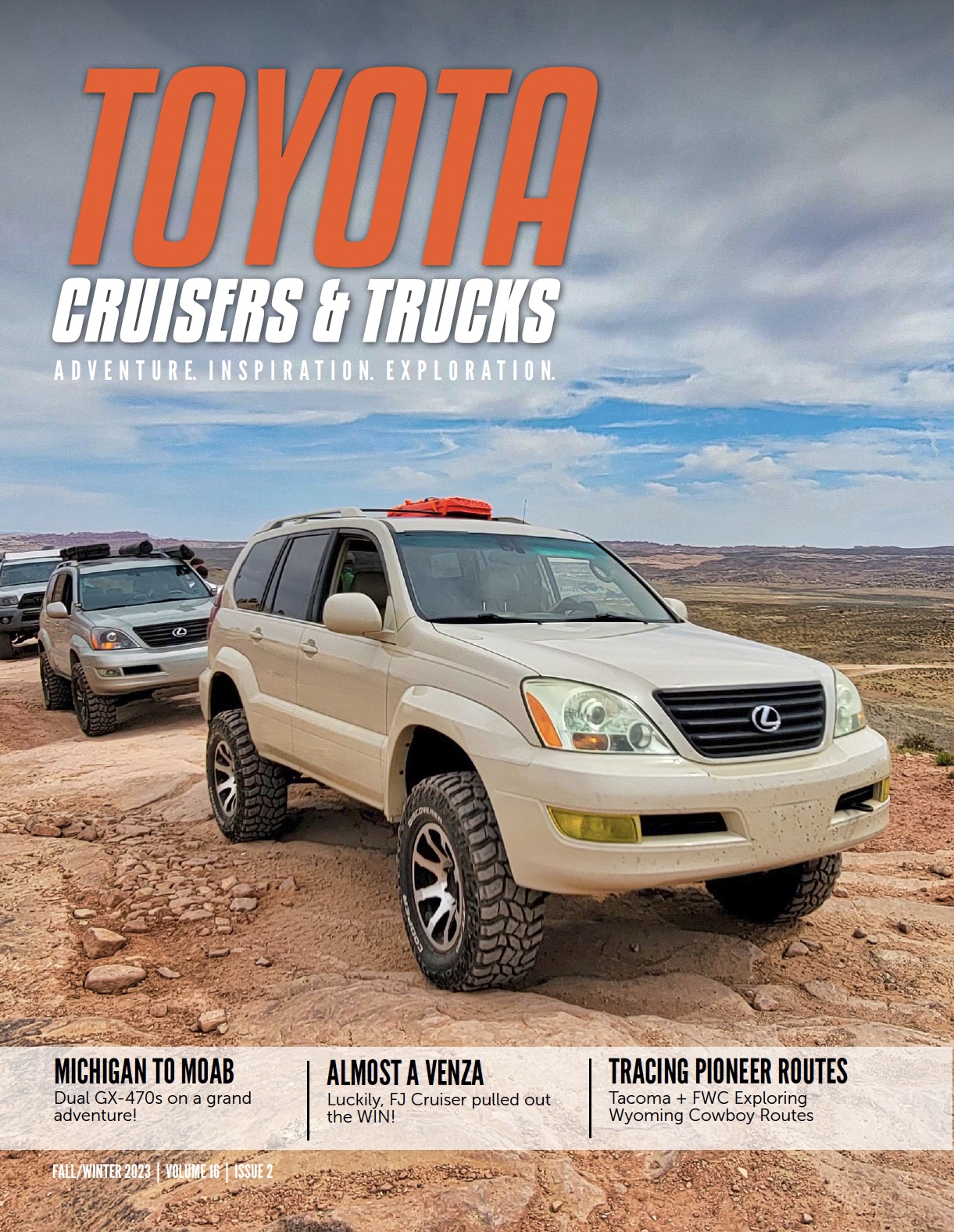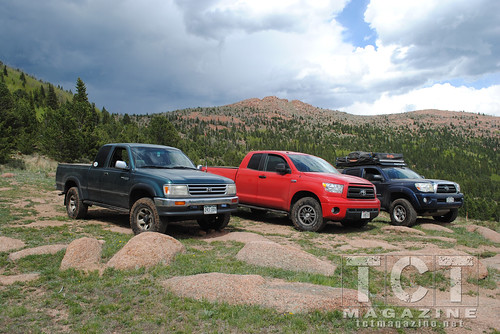 Capacity is my first consideration. The older I become, the more remote I like to get when traveling and the more comfortable I like to be when I arrive at camp. That means I need to carry plenty of creature comfort and support items with me. But that’s not to say that I simply go out and buy the biggest Tundra I can find. It’s important to strike a balance between what you need to carry and what you simply want to carry, and to buy a vehicle tailored to your most common load plan. And always remain vigilant against overdoing it, as loading beyond the vehicle’s capacity (gross vehicle weight rating) can have dangerous consequences on steering and braking, and greatly increases cost-per-mile economy.
Capacity is my first consideration. The older I become, the more remote I like to get when traveling and the more comfortable I like to be when I arrive at camp. That means I need to carry plenty of creature comfort and support items with me. But that’s not to say that I simply go out and buy the biggest Tundra I can find. It’s important to strike a balance between what you need to carry and what you simply want to carry, and to buy a vehicle tailored to your most common load plan. And always remain vigilant against overdoing it, as loading beyond the vehicle’s capacity (gross vehicle weight rating) can have dangerous consequences on steering and braking, and greatly increases cost-per-mile economy.
Comfort becomes more important with every passing mile––especially when those miles are measured by the hundreds on poorly maintained, primitive roads. There was a time in each of our lives when we could enjoy endless, pain-free miles from the seat of a vintage FJ40. Conversely, there comes a time when we begin to appreciate the level of refinement found in late model Cruisers. For most of us, an acceptable balance exists somewhere in between. Consider interior amenities like bolstered seats with lumbar support, power locks and windows, and noise insulation. Don’t overlook the important comfort features under your truck, though. Coils provide a smoother ride than leaf springs, and although a solid front axle offers better off-road prowess, a modern IFS can hold its own on the trail while providing significantly better road manners.
 Economy, in a nutshell, is our cost of ownership, and includes three primary factors: purchase price, out of pocket expense, and depreciation. In total, these three things can have a dramatic impact on our ability to put miles behind us by limiting our available travel budget. Even if the purchase price is agreeable, be sure to check a service manual and relevant online forums for frequency and costs on things like factory parts and repairs. Of course, fuel mileage and insurance premiums can vary greatly, so investigate those thoroughly prior to pulling the trigger. Finally, gauge the vehicle’s resale value and calculate depreciation. Do your best to average all of those costs for the period of time you expect to own the vehicle.
Economy, in a nutshell, is our cost of ownership, and includes three primary factors: purchase price, out of pocket expense, and depreciation. In total, these three things can have a dramatic impact on our ability to put miles behind us by limiting our available travel budget. Even if the purchase price is agreeable, be sure to check a service manual and relevant online forums for frequency and costs on things like factory parts and repairs. Of course, fuel mileage and insurance premiums can vary greatly, so investigate those thoroughly prior to pulling the trigger. Finally, gauge the vehicle’s resale value and calculate depreciation. Do your best to average all of those costs for the period of time you expect to own the vehicle.
Maintainability is a vehicle consideration that can be absolutely critical when things go wrong and you find yourself far from help. With the complex systems on modern vehicles, the chance of a trailside fix on major breakages is becoming less and less likely every year. Furthermore, if common maintenance must be executed with specialized diagnostics and tools, then you can go ahead and dock a few more points from the previous metric of economy. Bottom line: having a vehicle that you’re capable of working on in most reasonable situations can save you time, money, and often, miles of walking.
Capability is something worthy of deep examination, as it can become a slippery rabbit hole if we’re not careful. It’s important to note that although overland travel will sometimes place demands on the off-road agility of our vehicles, it’s not the same as recreational “wheeling,” whereby drivers deliberately seek out difficult terrain. It is my belief that one can spend a highly fulfilling lifetime overlanding and never shift to 4WD. Capability, for all its bragging rights and exciting trail time, more times than not has a direct negative impact to almost every other vehicle metric. Therefore, it’s important to understand exactly the type of terrain you anticipate covering, and demand from yourself an honest response to the question, “How much off-road capability can I live without?”
Performance is one of those metrics I used to discount, but as a former Vanagon driver who upgraded to a 100 Series, I am now convinced––by the glory of the Toyota gods and a stern V8!––that performance has huge value in any travel vehicle. As long-range overlanders, we’re accustomed to cramming ten pounds of manure into a five pound bag. Many of us will add extra pounds with an aftermarket suspension, tire and wheels, and armor. Oh, and don’t forget the roof rack full of stuff we rarely use or the sexy off-road trailer with its own ton of toys. In the end, having a travel platform with the muscle to haul and tow that gear while continuing to accelerate, corner, and brake within factory specs, will not only ensure that repair bills are lower over time, but that you’ll be safer and happier across every mile.
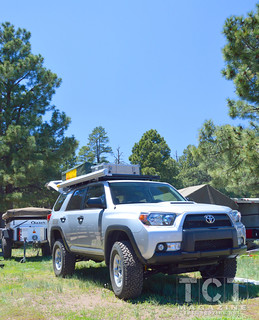 Reliability of any vehicle type has two primary sources: scientific study and anecdotal evidence. It’s important to consider both when choosing your next travel platform. JD Power and Consumer Reports, among a host of others, provide reliability ranking by categorizing empirical data from a range of sources––rankings which have proven themselves so accurate, in fact, that manufacturers use them to make annual adjustments to their offerings. Experiential knowledge is just as valuable, though, and comes from the collective stories of countless model owners, and includes reputation on both sides of the spectrum, good and bad. Forums are a great place to learn more about every make and model. (Thankfully for us Toyota truck owners, we don’t have to worry too much about this one, by and large.)
Reliability of any vehicle type has two primary sources: scientific study and anecdotal evidence. It’s important to consider both when choosing your next travel platform. JD Power and Consumer Reports, among a host of others, provide reliability ranking by categorizing empirical data from a range of sources––rankings which have proven themselves so accurate, in fact, that manufacturers use them to make annual adjustments to their offerings. Experiential knowledge is just as valuable, though, and comes from the collective stories of countless model owners, and includes reputation on both sides of the spectrum, good and bad. Forums are a great place to learn more about every make and model. (Thankfully for us Toyota truck owners, we don’t have to worry too much about this one, by and large.)
Safety & Security With more than 30,000 Americans killed each year in accidents, and with about $4 billion in losses reported annually to vehicle theft and break-in, it’s no wonder that safety and security are among the top factors considered when purchasing any new ride. Potentially amplifying those numbers are the big miles we drive as overlanders, the technical terrain in which we often find ourselves, the added weight of a full kit and its impact on handling, and finally, all of the high-dollar widgets we carry within and bolt onto our vehicles. It’s reasonable to expect safety and security to be even more critical to us. Consider a range of factory safety features that are important to you (and how aftermarket components can impact them!), and think about keeping a low profile with bolt-ons widgets so as to not attract ne’er-do-wells.
The most important thing to know prior to purchasing your next overland travel platform is that there is no perfect vehicle for everyone in all situations. What works for my family and the way we travel might be a terrible fit for yours, and what suits us beautifully on weekend trips might become painful during a trans-continental one. This sounds like common sense, but years of vehicle-based travel and guiding has taught me that many of us have a hard time letting go of preconceived notions about what’s best or even necessary.
So no pressure. Relax and enjoy the buying and vehicle preparation experience, allowing each decision to unfold before you based on careful consideration. The best Toyota for you and your travels will be revealed when you approach this search objectively and measure specific metrics individually based upon your own needs. The previous eight criteria are each quantifiable and specific to long-range, self-supported, vehicle-based travel, and will help you greatly when the time comes to select your next overlanding platform.
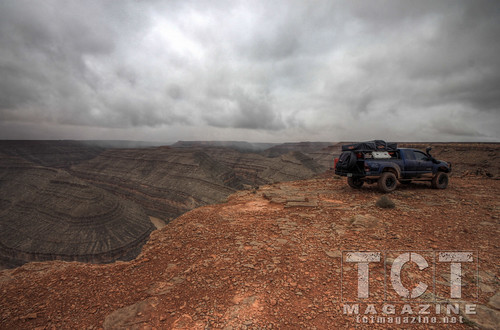
All Photos!
[flickr set=72157640078606675]
To get your copy of the January 2014 issue of TCT Magazine:FIND US ON: |

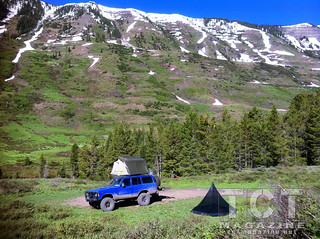 Our Toyotas are more than a simple mode of transportation. They are an extension of ourselves, both in personality and functionality. Besides the obvious reason of dashing good looks, we choose a particular make and model based on how we expect it to perform in the myriad conditions we’re likely to encounter during ownership. And when factory offerings are not generous enough, we’ll spend thousands in hard-earned dollars on aftermarket accessories to ensure that our vehicle is as close to ideal as possible. This principle rings true whether hanging some seatback DVD players in the Swagger Wagon or plumbing nitrous into a Supra for track days.
Our Toyotas are more than a simple mode of transportation. They are an extension of ourselves, both in personality and functionality. Besides the obvious reason of dashing good looks, we choose a particular make and model based on how we expect it to perform in the myriad conditions we’re likely to encounter during ownership. And when factory offerings are not generous enough, we’ll spend thousands in hard-earned dollars on aftermarket accessories to ensure that our vehicle is as close to ideal as possible. This principle rings true whether hanging some seatback DVD players in the Swagger Wagon or plumbing nitrous into a Supra for track days. 



